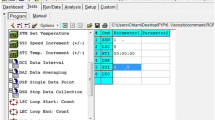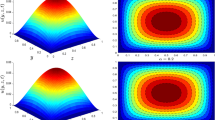Abstract
MXene, a recently created nanomaterial, offers significant potential for thermal, electrical, and a variety of other uses. MXene was utilized to generate heat transfer nanofluids with improved thermophysical properties for thermal applications and to establish the optimal parameters for achieving the best thermal performance. In this study, a palm oil/MXene nanofluid was used as the heat transfer fluid in a circular pipe to evaluate its thermal impact at different Reynolds numbers and applied heat fluxes at a range of introduced MXene nanoparticles’ concentrations. Thermal conductivity and viscosity were shown to be linked to temperature and nanoparticle concentrations ranging from 0.01 to 0.1 mass%. The influence of concerted MXene nanoparticles (0.01 to 0.1 mass%) on the behavior of the PO/MXene nanofluid was studied using CFD simulations at various flow Reynolds numbers (2,500–5,000) and wall heat fluxes (40,000–90,000 W.m−2). The results indicate that increasing the nanoparticle concentration resulted in higher heat transfer coefficients and lower Nusselt numbers. MXene nanoparticles were more efficient at lowering the wall temperature and increasing the pace of cooling when applied at larger heat fluxes and lower Re numbers. The results reported in this article indicate that MXene nanomaterials have a strong potential for overcoming the low heat transfer difficulties encountered in heat exchange systems.
















Similar content being viewed by others
Abbreviations
- PO :
-
Palm Oil
- Nu :
-
Nusselt Number
- Re :
-
Reynolds Number
- OPO :
-
Olein Palm Oil
- EG :
-
Ethylene Glycol
- GNP :
-
Graphene Nanoplatelets
- SO :
-
Soybean Oil
- POME :
-
Palm Oil Methyl Ester
- Φ:
-
Nanoparticles mass concentration (mass%)
- μ :
-
Dynamic viscosity, Pa.s
- Ρ:
-
Density, kg m−3
- nf :
-
Nanofluid
- np :
-
Nanoparticles
- bf :
-
Base fluid
- T :
-
Temperature, ˚C
- Δp :
-
Pressure drop, Pa/m
- L :
-
Length of the pipe, m
- h :
-
Heat transfer coefficient, W.m−2.K−1
- D :
-
Pipe diameter, m
- k :
-
Thermal conductivity, W.m−1.K−1
- m :
-
Mass, kg
- x :
-
Horizontal direction
- Q :
-
Applied heat flux, W/m2
- y :
-
Vertical direction
- c p :
-
Specific heat, J.kg−1.K−1
References
Mahian O, Kolsi L, Amani M, Estellé P, Ahmadi G, Kleinstreuer C. Recent advances in modeling and simulation of nanofluid flows-Part I: fundamentals and theory. Phys Rep. 2019;790:1–48. https://doi.org/10.1016/j.physrep.2018.11.004.
Wen D, Lin G, Vafaei S, Zhang K. Review of nanofluids for heat transfer applications. Particuology. 2009;7(2):141–50.
Sajid MU, Ali HM. Recent advances in application of nanofluids in heat transfer devices : a critical review. Renew Sustain Energy Rev. 2019;103:556–92. https://doi.org/10.1016/j.rser.2018.12.057.
Bao Z, Bing N, Zhu X, Xie H, Yu W. Ti3C2Tx MXene contained nanofluids with high thermal conductivity, super colloidal stability and low viscosity. Chem Eng J. 2021;406:126390. https://doi.org/10.1016/j.cej.2020.126390.
Nazari MA, Ahmadi MH, Sadeghzadeh M, Shafii MB, Goodarzi M. A review on application of nanofluid in various types of heat pipes. J Central South Univ. 2019;26(5):1021–41.
Poplaski LM, Benn SP, Faghri A. Thermal performance of heat pipes using nanofluids. Int J Heat Mass Transf. 2017;107:358–71.
Sureshkumar R, Mohideen ST, Nethaji N. Heat transfer character- istics of nanofluids in heat pipes: a review. Renew Sustain Energy Rev. 2013;20:397–410.
Rubbi F, Habib K, Saidur R, Aslfattahi N, Yahya SM, Das L. Performance optimization of a hybrid PV/T solar system using Soybean oil/MXene nanofluids as A new class of heat transfer fluids. Sol Energy. 2020;208:124–38. https://doi.org/10.1016/j.solener.2020.07.060.
Samylingam L, Aslfattahi N, Saidur R, Mohd S, Afzal A. Thermal and energy performance improvement of hybrid PV/T system by using olein palm oil with MXene as a new class of heat transfer fluid. Sol Energy Mater Sol Cells. 2020;218:110754. https://doi.org/10.1016/j.solmat.2020.110754.
Parashar N, Aslfattahi N, Yahya SM, Saidur R. An artificial neural network approach for the prediction of dynamic viscosity of MXene-palm oil nanofluid using experimental data. J Therm Anal Calorim. 2021;144(4):1175.
Parashar N, Aslfattahi N, Yahya SM, Saidur R. ANN modeling of thermal conductivity and viscosity of MXene-based aqueous IoNanofluid. Int J Thermophys. 2021;42:1–24. https://doi.org/10.1007/s10765-020-02779-5.
Rafieerad M, et al. New water-based fluorescent nanofluid containing 2D titanium carbide MXene sheets: a comparative study of its thermophysical, electrical and optical properties with amine and carboxyl covalently functionalized graphene nanoplatelets. J Therm Anal Calorim. 2021;146(4):1491–504.
Rahmadiawan D, Aslfattahi N, Nasruddin N, Saidur R. Rahmadiawan, D., Aslfattahi, N., Nasruddin, N., Saidur, R., Arifutzzaman, A. and Mohammed, H.A., 2021. MXene based palm oil methyl ester as an effective heat transfer fluid. In: J Nano Res. Vol. 68, pp. 17–34. Trans Tech Publications Ltd. 2021.
Aslfattahi N, Samylingam L, Abdelrazik AS, Arifutzzaman A, Saidur R. MXene based new class of silicone oil nanofluids for the performance improvement of concentrated photovoltaic thermal collector. Sol Energy Mater Sol Cells. 2020;211:110526. https://doi.org/10.1016/j.solmat.2020.110526.
Aslfattahi N, et al. Experimental investigation of energy storage properties and thermal conductivity of a novel organic phase change material/MXene as a new class of nanocomposites. J Energy Storage. 2020;27:101115.
Das L, Habib K, Saidur R, Aslfattahi N, Yahya SM, Rubbi F. Improved thermophysical properties and energy efficiency of aqueous ionic liquid/mxene nanofluid in a hybrid pv/t solar system. Nanomaterials. 2020;10:1–26.
Bakthavatchalam B, Habib K, Saidur R, Aslfattahi N, Yahya SM, Rashedi A, et al. Optimization of thermophysical and rheological properties of mxene ionanofluids for hybrid solar photovoltaic/thermal systems. Nanomaterials. 2021;11(2):320.
Javed M, Shaik AH, Khan TA, Imran M, Aziz A, Ansari AR, et al. Synthesis of stable waste palm oil based CuO nanofluid for heat transfer applications. Heat mass transf und Stoffuebertragung. Heat Mass Trans. 2018;54:3739–45.
Hussein AM, Lingenthiran KK, Noor MM, Aik LK. Palm oil based nanofluids for enhancing heat transfer and rheological properties. Heat mass transf und Stoffuebertragung. Heat Mass Trans. 2018;54:3163–9.
Ramachandran S, Kalaichelvi P, Sundaram S. Heat transfer studies in a spiral plate heat exchanger for water - palm oil two phase system. Braz J Chem Eng. 2008;25:483–90.
Samylingam L, Aslfattahi N, Saidur R, Yahya SM, Afzal A, Arifutzzaman A, et al. Thermal and energy performance improvement of hybrid PV/T system by using olein palm oil with MXene as a new class of heat transfer fluid. Sol Energy Mater Sol Cells. 2020;218:110754. https://doi.org/10.1016/j.solmat.2020.110754.
Parashar, N, et al. Prediction of the dynamic viscosity of MXene/palm oil nanofluid using support vector regression. In: Recent Trends in Thermal Engineering. Singapore: Springer; 2022. pp. 49–55.
Parashar N, Aslfattahi N, Mohd S, Saidur YR. An artificial neural network approach for the prediction of dynamic viscosity of MXene - palm oil nanofluid using experimental data. J Therm Anal Calorim. 2021;144:1175–86. https://doi.org/10.1007/s10973-020-09638-3.
Bårdsgård R, Kuzmenkov DM, Kosinski P, Balakin BV. Eulerian CFD model of direct absorption solar collector with nanofluid. J Renew Sustain Energy. 2020;12:033701.
Sharaf OZ, Al-khateeb AN, Kyritsis DC, Abu-nada E. Direct absorption solar collector ( DASC ) modeling and simulation using a novel Eulerian-Lagrangian hybrid approach : optical, thermal, and hydrodynamic interactions. Appl Energy. 2018;231:1132–45. https://doi.org/10.1016/j.apenergy.2018.09.191.
Cengel YA, Ghajar AJ. Boiling and condensation. In: Heat and mass transfer: Fundamentals and applications, 4th ed. McGraw-Hill Higher Education; 2011. 515–60.
Incropera FP, DeWitt DP, Bergman TL, Lavine AS. Fundamentals of heat and mass transfer, vol. 6. New York: Wiley; 1996.
Abdelrazek AH, Kazi SN, Alawi OA, Yusoff N, Oon CS, Ali HM. Heat transfer and pressure drop investigation through pipe with different shapes using different types of nanofluids. J Therm Anal Calorim. 2020;139:1637–53. https://doi.org/10.1007/s10973-019-08562-5.
Author information
Authors and Affiliations
Corresponding author
Additional information
Publisher's Note
Springer Nature remains neutral with regard to jurisdictional claims in published maps and institutional affiliations.
Rights and permissions
Springer Nature or its licensor (e.g. a society or other partner) holds exclusive rights to this article under a publishing agreement with the author(s) or other rightsholder(s); author self-archiving of the accepted manuscript version of this article is solely governed by the terms of such publishing agreement and applicable law.
About this article
Cite this article
Abdelrazik, A.S., Saidur, R. & Al-Sulaiman, F.A. Insights on the thermal potential of a state-of-the-art palm oil/MXene nanofluid in a circular pipe. J Therm Anal Calorim 148, 913–926 (2023). https://doi.org/10.1007/s10973-022-11795-6
Received:
Accepted:
Published:
Issue Date:
DOI: https://doi.org/10.1007/s10973-022-11795-6




